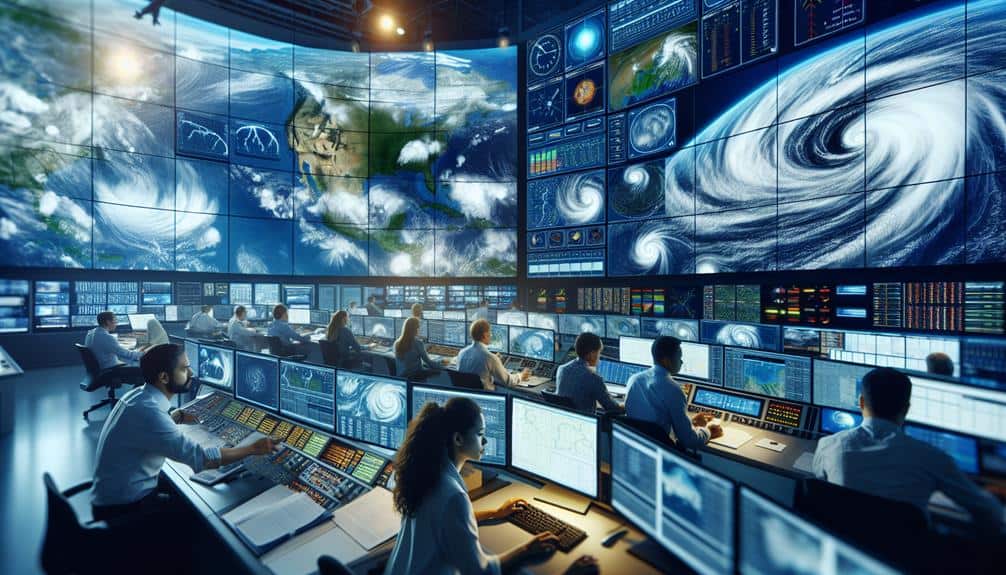We study hurricane behavior amidst climate change using satellite data analysis, field research expeditions, and computer simulations. Satellite data tracks hurricane intensity and patterns over time, with machine learning enhancing data interpretation. Field research provides real-time data on wind speeds, sea temperatures, and other factors directly from hurricanes. Through computer simulations, we model various climate scenarios to predict future hurricane behavior, ensuring our models are accurate by comparing them with historical data. Each method complements the others, giving us a thorough understanding of changing hurricane dynamics. Learn exactly how these methods contribute to our insights on this pressing issue.
Key Points
- Analyze satellite data using machine learning algorithms to track hurricane intensity, frequency, and patterns.
- Conduct field research expeditions for real-time data on wind speeds, pressure, humidity, and sea temperatures.
- Utilize computer simulations to predict hurricane behavior under various climate change scenarios.
- Validate computer models by comparing simulated outcomes with historical hurricane data.
Satellite Data Analysis
With satellite data, we can accurately track and analyze the intensity, frequency, and patterns of hurricanes over time. This capability allows us to observe trends and shifts that are indicative of climate change impacts.
By employing machine learning algorithms, we can sift through vast amounts of satellite imagery and sensor data more efficiently than ever before. These algorithms enable us to identify complex patterns and anomalies that might elude traditional analysis methods.
Data visualization tools play a pivotal role in interpreting these findings. By transforming raw data into detailed visual formats, we make the information accessible and understandable.
For instance, heat maps can show the concentration of hurricane activities over specific regions, while time-lapse animations can illustrate changes in hurricane frequency and intensity over decades.
Our approach empowers us with the freedom to make data-driven decisions and forecasts. By leveraging satellite data, machine learning, and data visualization, we not only deepen our understanding of hurricane behavior but also enhance our predictive capabilities.
This knowledge is essential for developing more effective strategies to mitigate the impact of hurricanes on vulnerable communities worldwide.
Field Research Expeditions
Field research expeditions provide vital on-the-ground data that complements satellite observations, enabling a deeper understanding of hurricane dynamics. By deploying advanced instruments directly into the path of storms, we gather high-resolution data that's unattainable from space. This real-time data collection includes wind speeds, barometric pressure, humidity levels, and sea surface temperatures, all of which are essential for evaluating a hurricane's intensity and potential impact.
One of the key elements of field research is storm tracking. By following the storm's trajectory closely, we can capture the rapid changes that occur in its structure and behavior. This allows us to validate and enhance the predictive models derived from satellite data. The more we learn about the storm's evolution, the better we can refine our forecasting techniques, ultimately leading to more accurate warnings for affected regions.
Our expeditions often involve collaboration with multiple agencies and use a variety of platforms, such as aircraft, ocean buoys, and unmanned aerial vehicles (UAVs). Each platform provides unique data streams that, when integrated, offer a thorough view of the hurricane system. This multi-faceted approach is crucial for understanding the complex interactions between atmospheric and oceanic processes driven by climate change.
Computer Simulations
Computer simulations play a vital role in predicting hurricane behavior by allowing us to model complex atmospheric and oceanic interactions under various climate scenarios. These simulations enable us to understand potential changes in hurricane frequency, intensity, and trajectory as global temperatures rise. By integrating vast amounts of meteorological data, we can create sophisticated models that mimic real-world conditions.
The accuracy of these simulations depends heavily on model validation. We compare simulated outcomes with historical hurricane data to verify our models are reliable. This process is essential for identifying discrepancies and refining algorithms. When our models align well with past events, we gain confidence in their predictive capabilities for future scenarios.
Data interpretation is another crucial aspect. We must analyze the outputs from our simulations meticulously. Trends in sea surface temperatures, wind patterns, and atmospheric pressure all provide insights into how hurricanes might evolve. By interpreting this data, we can make informed predictions and prepare for potential impacts.
Ultimately, computer simulations give us the freedom to explore a range of possibilities without waiting for real-world events to unfold. They allow us to proactively plan and mitigate the risks associated with changing hurricane behaviors due to climate change.
Frequently Asked Questions
How Does Climate Change Impact Hurricane Intensity and Frequency?
We've observed that climate change increases hurricane intensity and frequency. Using climate models and improved hurricane forecasting, we can better understand these effects. Enhanced climate adaptation and disaster response strategies are essential for mitigating risks and safeguarding communities.
What Historical Data Is Used to Study Past Hurricane Patterns?
When studying past hurricane patterns, we reveal the treasure chest of historical data sources, applying statistical analysis to uncover geographic patterns. Trend analysis of this data reveals hidden truths, guiding us toward understanding and forecasting future hurricane behaviors.
How Do Ocean Temperatures Influence Hurricane Development?
We can see the impact of warming ocean temperatures on hurricane development through increased intensity and frequency. Ocean circulation changes also play a role, distributing heat unevenly, which affects storm formation and strength. Data confirms these trends.
What Role Do Wind Patterns Play in Hurricane Behavior?
Let's cut to the chase: wind patterns have a substantial impact on hurricane behavior by influencing their direction and intensity. Atmospheric circulation, especially variations in jet streams, can steer hurricanes or inhibit their formation, dictating their potential threat levels.
How Can Communities Better Prepare for Increasingly Severe Hurricanes?
We can enhance community resilience and improve disaster response by investing in robust infrastructure, early warning systems, and public education. Data shows these measures greatly reduce damage and save lives during increasingly severe hurricanes.

